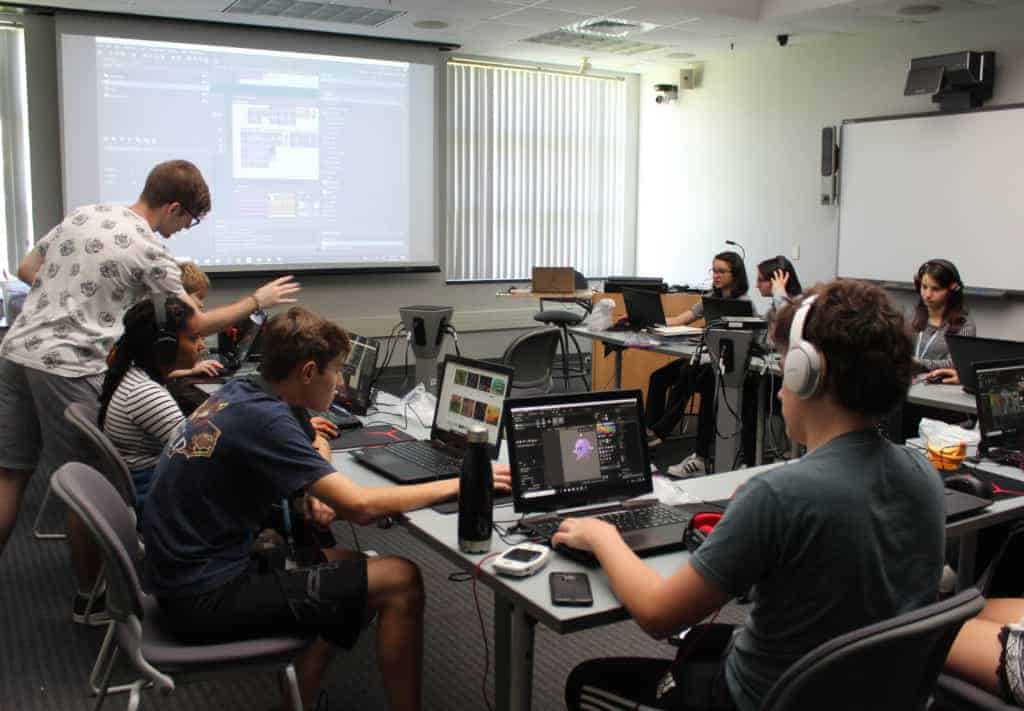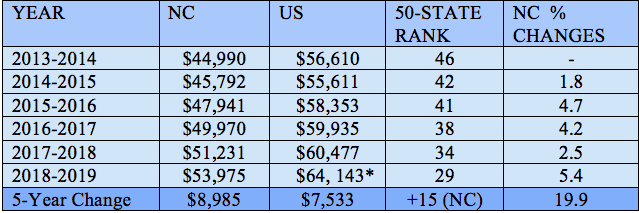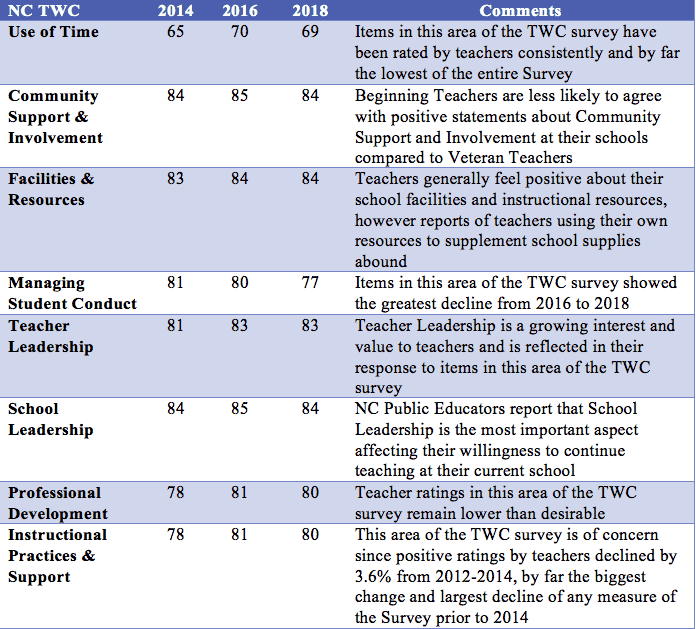With schools now open for the 2019-2020 school year, this month’s piece from the STEM ScoreCard has a fitting focus: teacher quality.
Researchers argue that the single most important factor affecting student achievement is teachers, and the effects of teachers on student achievement are both additive and cumulative. Further, lower-achieving students are the most likely to benefit from increases in teacher effectiveness. Only parents or guardians have more influence over how well young people perform in school.
Assuring a quality teaching force in public schools is an essential state responsibility. In order to achieve and sustain a sufficient supply of well-prepared STEM teachers whose talents are distributed across a diversity of students and schools, two key questions to consider are:
- Are the incentives and support structures in North Carolina strong enough to attract candidates into STEM teaching in numbers sufficient to assure that all students are taught by competent and fully-qualified STEM teachers?
- Are the incentives and support structures sufficient in North Carolina to retain competent and fully-qualified STEM teachers?
Answers to these questions can be found through looking at teacher salary, working conditions, and teacher turnover more broadly (not just in STEM). I dive into data in each of these areas below.


Average North Carolina teacher salary
Most people choose to enter the teaching profession due to a wholesome love for young people and a desire to make a difference. Nevertheless, teachers are well-educated and want to support a reasonably comfortable lifestyle with their careers.
After years of decline, the average teacher salary of North Carolina teachers (in current dollars) has increased overall by 8.3% from 2013-14 to 2018-19, according to the National Education Association. During this same time frame, North Carolina rose in national rankings from 46th to 29th in average state teacher’s salaries. This followed five previous years of decline beginning in 2009-10. (Note: North Carolina was 20th in the nation in 2001-2002.)


Teacher salary is a complicated and often confusing story in North Carolina. As the North Carolina Public School Forum has reported:
- The average teacher salary in more than 80% of North Carolina’s school districts fall below the reported state average salary.
- Average teacher salary varies widely from district to district due to inequities in local supplements, which are funded through local property taxes. Thus, the poorer counties have less revenue to supplement teacher’s state salary. (Not surprisingly, these are the same counties with the highest numbers of non-fully certified science and math teachers and the lowest performing students in the STEM disciplines.)
- Teachers in North Carolina are paid well below their similarly educated and experienced peers.
To this final point — nationally, teachers are paid 21.4% less than similarly educated and experienced professionals according to a National Education Today report, which found that the “teacher pay gap” reached a record high in 2018. This difference between teacher pay and other college-educated professionals’ pay is partly due to the persistent gender gap in wages. Across all full-time jobs in the U.S., women earn about 80% of men’s salaries. Historically, teaching has been a profession made up mostly of women. Today, 76.6% of educators are women.
Teacher working conditions
The North Carolina Teacher Working Conditions (NC TWC) Survey was established in 2002 by the North Carolina Professional Teaching Standards Commission. Research has shown that teaching conditions are positively associated with improved student achievement and teacher retention. North Carolina became the first state in the nation to study teacher working conditions by surveying those whose opinion matters most on these issues — teachers themselves. It was the first attempt in the nation for a state to survey its entire licensed staff. Then-Governor Mike Easley became aware of the initiative and adopted it as part of the Governor’s Teacher Working Conditions Initiative (2002-2008).
The number of NC TWC Survey items have been altered and increased over the years as the research base around teacher quality has improved. The eight scales of the survey are:
Time — Available time to plan, collaborate, provide instruction, and eliminate barriers to maximize instructional time during the school day
Community Support and Involvement — Community and parent/guardian communication and influence in the school
Facilities and Resources — Availability of instructional, technology, office, communication, and school resources to teachers
Managing Student Conduct — Policies and practices to address student conduct issues and ensure a safe school environment
Teacher Leadership —Teacher involvement in decisions that impact classroom and school practices
School Leadership — Ability of school leadership to create trusting, supportive environments and address teacher concerns
Professional Development — Availability and quality of learning opportunities for educators to enhance their teaching
Instructional Practices and Support — Data and support available to teachers to improve instruction and student learning
Below are positive ratings (%) in each of these categories: 

In the 2018 results, 87% of educators agreed with this statement: “Overall, my school is a good place to work and learn.” A total of 95,922 teachers completed the survey in 2018. This was the highest response rate ever for NC TWC. There is a separate survey for school principals, with more than nine out of 10 educators responding to the survey overall. This is up from 38% from 2004, the first year the survey was administered.


Teacher turnover
Teacher turnover is of strategic interest to every state, given the important role that teachers have in producing students prepared for higher learning or for more immediate workforce development.
While a breakout of teacher retention/turnover by subject discipline is not available, generally, North Carolina teachers are remaining in the classroom. According to the Department of Public Instruction (DPI), the overall state attrition rate for 2017-2018 was 8.1%. The attrition rate for beginning teachers in North Carolina was 12.34%, substantially higher than the attrition rate for those not classified as a beginning teacher (7.25%).
The majority (53.9%) of teachers who left employment in North Carolina public schools cited “personal reasons” for their decision to depart. Retirement with full benefits and family relocation were the largest individual reasons (21.5% and 12.3%, respectively) cited for teachers’ decision to leave employment in North Carolina public schools.
Data from DPI also indicates an average of 4.4% of teachers transferred to another district within the state, but an additional 9% left entirely.
Notably, in 2017-18, 9.2% reported that they resigned to teach in another state. While there may be many reasons for teachers and other educators deciding to relocate in another state, one of those may be salary-related. As seen in the table below, the average instructional pay is higher in every state that borders North Carolina.


Hard to staff subject areas are determined by teacher vacancy reports submitted by the Local Education Agency (LEA). For elementary schools, core subject teaching positions exhibit the highest vacancy totals. In middle schools (6-8), LEAs have the highest vacancies for mathematics. In high schools (9-12), the highest vacancies are for Career and Technical Education (CTE), many of which are STEM-related disciplines. For 2013-2014 (the last year for which data are available from DPI), of the 12,599 teacher turnovers reported, 4,093 took other positions in education, 1,122 were initiated by the LEA, 958 left for unknown or other reasons, and 1,011 left because of dissatisfaction with teaching and/or to pursue another career. The highest percentage turnover occurred in the rural lower paying districts of eastern North Carolina.


In summary
While still below the national average, North Carolina teacher salaries have continued to trend upward from our lowest national ranking of 46th in the nation in 2013-14. North Carolina is currently the 9th most populous state and had the 12th highest Gross Domestic Product (GDP) in the United States in the 1st quarter of 2019. Yet, our average teacher salary is 29th in the nation.
It is also true that North Carolina’s median household income of $50,320 ranks 41st in the U.S. Nevertheless, policymakers must decide if commitment to attracting and retaining teachers is aligned with our resources and aspirations to improve the economy of the state and to grow the income of individuals and families.
Each section of the STEM ScoreCard is compiled by Charles Coble of Teacher Preparation Analytics and edited by Yasmin Bendaas at EdNC. Keep up with the STEM ScoreCard, released monthly, here.



